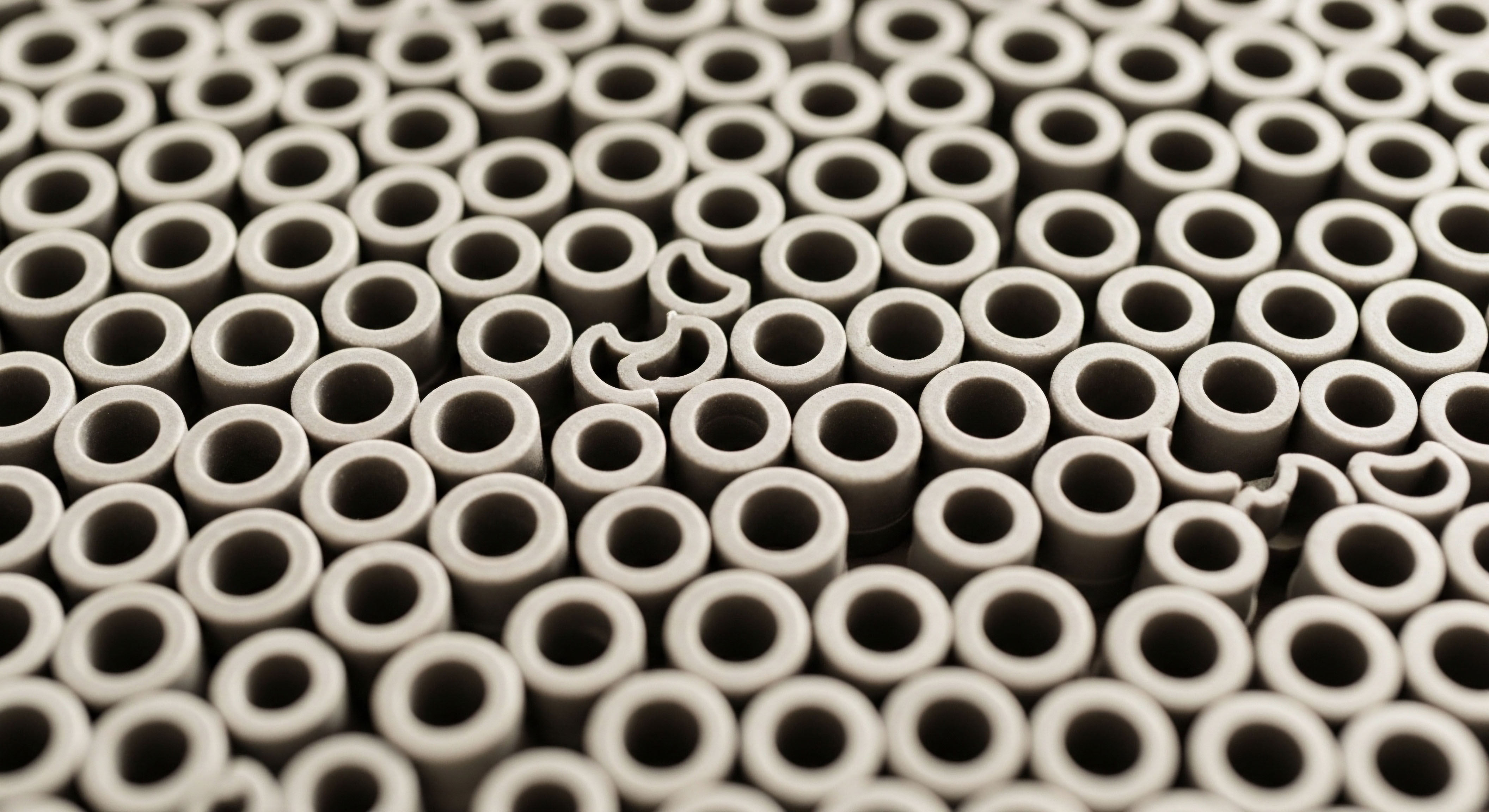

Fundamentals
You have begun a protocol of endocrine system support, a significant step toward reclaiming your vitality. You have the lab results, the clinical diagnosis of hypogonadism, and now, a prescription for testosterone replacement therapy (TRT). There is a common perception that this intervention is a switch that, once flipped, restores function completely.
Many men begin their therapeutic course with this expectation, only to find the reality is more complex. The sense of well-being, the enhanced energy, and the shifts in body composition may arrive, yet they might feel incomplete or accompanied by new concerns. This experience is valid and points toward a deeper biological truth. Your hormonal health operates within a dynamic, interconnected system, and introducing exogenous testosterone is a powerful input, not a standalone solution.
Think of your body as a high-performance vehicle. TRT provides the high-octane fuel ∞ the testosterone ∞ that the engine is designed to use. Diet and exercise are the ongoing maintenance, the quality of the oil, the pressure in the tires, and the skill of the driver.
Supplying premium fuel to a poorly maintained engine will yield disappointing results and may even cause damage. Similarly, optimizing your testosterone levels without addressing the environment in which that hormone must function limits the potential benefits and can amplify certain risks.
The foods you consume and the physical demands you place on your body dictate how efficiently that testosterone is used, how well its potential side effects are managed, and ultimately, the quality of your clinical outcome. Lifestyle modifications are the synergistic factors that allow the full potential of hormonal optimization to be expressed.
Lifestyle choices actively shape the biological environment where testosterone therapy operates, influencing both its effectiveness and its associated risks.

The Interplay of Testosterone and Body Composition
Testosterone’s primary and most sought-after effects include the promotion of lean muscle mass and the reduction of adipose tissue, or body fat. When you begin a TRT protocol, the therapy itself provides a potent signal for muscle protein synthesis. This is the process your body uses to repair and build muscle fibers.
However, this signal requires raw materials. A diet rich in high-quality protein supplies the essential amino acids necessary to construct new muscle tissue. Without adequate protein, the body cannot fully capitalize on the anabolic signals provided by the therapy. You are supplying the architectural blueprint (testosterone) without providing the bricks and mortar (protein).
Simultaneously, exercise, particularly resistance training, acts as the catalyst for this construction process. Lifting weights creates microscopic tears in muscle fibers, a stimulus that signals the body to rebuild them stronger and larger. When combined with optimized testosterone levels, this stimulus is met with a robust and efficient response.
The synergy between resistance training and adequate testosterone is profound; one enhances the effects of the other in a powerful feedback loop. This process increases your metabolic rate, as muscle tissue is more metabolically active than fat tissue, helping your body to burn more calories even at rest. This synergy is fundamental to reshaping your body composition and is entirely dependent on your active participation through diet and physical activity.


Intermediate
Understanding that lifestyle choices are integral to a successful hormonal optimization protocol allows us to examine the specific biological mechanisms at play. A well-designed diet and a consistent exercise regimen are precision tools that can directly mitigate the most common risks associated with testosterone replacement therapy. These interventions are not merely supportive; they are actively protective, influencing key enzymatic processes and physiological functions that can become problematic if left unaddressed during therapy.

The Aromatase Equation Adipose Tissue and Estrogen
One of the primary metabolic pathways for testosterone is its conversion into estradiol, a form of estrogen, through an enzyme called aromatase. This process is natural and necessary, as men require a certain amount of estrogen for bone health, cognitive function, and libido. The issue arises from the location of aromatase activity.
Adipose tissue is a primary site of aromatase expression in men. Consequently, a higher body fat percentage means more aromatase enzymes are available to convert testosterone into estrogen. When you introduce exogenous testosterone via TRT, you provide more substrate for this conversion. In an individual with excess adipose tissue, this can lead to supraphysiological levels of estradiol.
This elevated estrogen level is responsible for several potential side effects of TRT, including water retention, gynecomastia (the development of breast tissue), and mood fluctuations. To counteract this, clinicians often prescribe an aromatase inhibitor (AI) like Anastrozole. While effective, this adds another medication to your protocol.
A more foundational strategy is to reduce the amount of adipose tissue itself. Through a combination of a calorie-controlled diet rich in whole foods and a consistent exercise program that builds muscle and burns fat, you directly reduce the body’s capacity for aromatization.
This can lower the required dose of an AI, and in some cases, may eliminate the need for it entirely. Lifestyle modification becomes your primary tool for managing estrogen, allowing the therapeutic testosterone to function as intended.
Reducing body fat through diet and exercise directly lowers aromatase activity, thereby helping to manage estrogen levels during testosterone therapy.

How Can Exercise Calibrate the Cardiovascular System?
Concerns about cardiovascular health are common when discussing TRT. While large-scale studies like the TRAVERSE trial have provided reassurance that TRT does not increase the risk of major adverse cardiovascular events in appropriately selected men, the therapy does influence certain cardiovascular markers. For instance, TRT can affect lipid profiles and blood pressure.
Here again, diet and exercise are powerful modulators. A diet low in processed foods and rich in fiber, omega-3 fatty acids (found in fish), and monounsaturated fats (found in olive oil and avocados) helps to maintain a healthy lipid profile.
Regular cardiovascular exercise, such as brisk walking, cycling, or high-intensity interval training (HIIT), strengthens the heart muscle, improves circulation, and helps regulate blood pressure. These lifestyle factors create a resilient cardiovascular system that is better equipped to handle the metabolic shifts associated with hormonal therapy.
The table below illustrates how a structured lifestyle protocol works in concert with TRT to optimize outcomes and mitigate risks, compared to relying on the therapy alone.
| Clinical Area | TRT Alone | TRT with Diet & Exercise |
|---|---|---|
| Body Composition |
Moderate increase in lean mass, potential for some fat loss. |
Significant increase in lean mass and substantial reduction in adipose tissue due to synergistic effects of anabolic signals and physical stimulus. |
| Estrogen Management |
Higher potential for aromatization, often requiring an Aromatase Inhibitor (AI) to control estradiol levels. |
Reduced aromatase activity due to lower body fat, decreasing the need for or dosage of an AI. |
| Cardiovascular Health |
Variable effects on lipid profiles and blood pressure. |
Improved lipid profiles, lower resting blood pressure, and enhanced cardiac efficiency. |
| Erythrocytosis Risk |
Increased risk, particularly in individuals with pre-existing risk factors like obesity or sleep apnea. |
Lowered risk due to improved metabolic health, weight management, and potential resolution of sleep apnea. |

Unlocking Testosterones Potential the Role of SHBG
Not all testosterone in your bloodstream is available for your tissues to use. A significant portion is bound to proteins, primarily Sex Hormone-Binding Globulin (SHBG). Only the “free” or unbound testosterone can enter cells and exert its effects. SHBG levels are influenced by various factors, including genetics, liver function, and importantly, metabolic health. Insulin resistance and high levels of circulating insulin, often associated with obesity and a sedentary lifestyle, tend to suppress SHBG levels.
While this might sound beneficial initially (lower SHBG means more free testosterone), the underlying metabolic dysfunction is the real issue. Structured exercise, particularly resistance training, has been shown to improve insulin sensitivity. Some studies suggest that resistance training can even increase SHBG levels in overweight men as their metabolic health improves.
This indicates a normalization of the endocrine system. By improving your metabolic health through exercise, you are ensuring that the regulation of free testosterone occurs within a healthier biological context, leading to more stable and effective results from your therapy.


Academic
A sophisticated clinical application of testosterone replacement therapy requires a deep appreciation for the physiological and biochemical pathways that lifestyle modifications can directly influence. Two of the most significant adverse events associated with TRT ∞ erythrocytosis and excessive aromatization ∞ are not isolated pharmacological side effects.
They are complex physiological responses whose incidence and severity are profoundly modulated by the patient’s underlying metabolic health. Therefore, diet and exercise are not merely adjunctive recommendations; they are targeted interventions aimed at altering the specific biological terrain in which TRT operates.

A Deeper Look at Adipose Tissue Aromatization
The conversion of androgens to estrogens is catalyzed by the enzyme aromatase, a product of the CYP19A1 gene. In males, while some aromatization occurs in the brain, bone, and testes, adipose tissue is the principal peripheral site of this conversion.
The expression of aromatase in adipocytes is not static; it is upregulated by factors including glucocorticoids and inflammatory cytokines, which are often elevated in states of obesity and metabolic syndrome. This creates a self-perpetuating cycle ∞ obesity increases aromatase activity, which raises estrogen levels; elevated estrogen can then promote further fat deposition and inhibit the hypothalamic-pituitary-gonadal (HPG) axis, suppressing endogenous testosterone production.
When exogenous testosterone is administered, it provides an abundance of substrate for this overactive enzymatic machinery. Research has demonstrated that weight loss, achieved through diet and exercise, directly addresses this issue. A study published in Frontiers in Endocrinology on obese hypogonadal men found that a weight loss program combined with an aromatase inhibitor was highly effective at normalizing the testosterone-to-estradiol ratio.
The lifestyle intervention itself is a powerful tool for reducing the total volume of aromatase-expressing tissue. This reduces the systemic conversion of testosterone to estradiol, thereby mitigating the risk of hyperestrogenemia and lessening the pharmacological dependence on AIs.
- Dietary Intervention ∞ A hypocaloric diet focused on reducing overall adiposity decreases the primary site of peripheral aromatization. Specific dietary patterns, such as those rich in anti-inflammatory compounds, may also modulate the local inflammatory environment within adipose tissue, potentially downregulating cytokine-driven aromatase expression.
- Exercise Intervention ∞ Resistance training increases lean body mass, which alters the body’s composition in favor of metabolically active tissue over fat tissue. This shift fundamentally changes the hormonal milieu, favoring testosterone utilization for muscle protein synthesis over conversion to estradiol.

The Pathophysiology of TRT Induced Erythrocytosis
Erythrocytosis, defined as an increase in hematocrit (HCT) or hemoglobin to supraphysiological levels (e.g. HCT >54%), is the most common adverse effect of TRT. The mechanism is multifactorial. Testosterone stimulates erythropoiesis by promoting the production of erythropoietin (EPO) from the kidneys and by acting directly on bone marrow progenitor cells.
It also suppresses hepcidin, a key regulator of iron availability, leading to increased iron for red blood cell production. While this is a normal physiological action of testosterone, certain conditions can amplify this response to a clinically significant degree.
Key risk factors for developing TRT-induced erythrocytosis, such as obesity and sleep apnea, are directly modifiable through targeted lifestyle changes.
Obesity is a significant independent risk factor for erythrocytosis. The mechanisms are thought to involve obesity-related hypoventilation and a higher prevalence of obstructive sleep apnea (OSA). Both conditions lead to intermittent hypoxia, which is a potent stimulus for EPO production.
When the EPO-stimulating effects of testosterone are layered on top of pre-existing hypoxia-driven EPO production, the risk of developing an unsafe level of red blood cell mass increases substantially. Lifestyle interventions are critical for mitigating this risk.
- Weight Management ∞ Reducing body weight is the most effective treatment for many cases of OSA. Resolving sleep apnea removes a major stimulus for EPO production, thereby lowering the baseline erythropoietic drive before TRT is even initiated.
- Improved Insulin Sensitivity ∞ There is emerging evidence that insulin itself can stimulate erythroid progenitor cells. Improving insulin sensitivity through diet and exercise may therefore have a direct dampening effect on the erythropoietic response to testosterone.
The table below details specific lifestyle strategies and their mechanistic impact on TRT-related risks.
| Risk Factor | Underlying Mechanism | Targeted Lifestyle Intervention | Biological Impact |
|---|---|---|---|
| High Estradiol |
Excessive aromatase activity in adipose tissue converting testosterone to estradiol. |
Reduction of body fat via diet and exercise. |
Decreases the total amount of aromatase enzyme, lowering the conversion rate and reducing the need for AIs. |
| Erythrocytosis (High HCT) |
Testosterone stimulates EPO and suppresses hepcidin. This is exacerbated by hypoxia from obesity-related sleep apnea. |
Weight loss to treat sleep apnea; cardiovascular exercise to improve oxygen efficiency. |
Reduces hypoxic stimulation of EPO production, lowering the overall erythropoietic drive and mitigating HCT elevation. |
| Poor Glycemic Control |
Insulin resistance is often co-morbid with hypogonadism and can be worsened by a sedentary lifestyle. |
Resistance training and a low-glycemic diet. |
Improves insulin sensitivity, which enhances nutrient partitioning into muscle and may reduce direct insulin-mediated stimulation of erythropoiesis. |

References
- Cho, D. Y. et al. “Exercise improves the effects of testosterone replacement therapy and the durability of response after cessation of treatment ∞ a pilot randomized controlled trial.” The World Journal of Men’s Health, vol. 35, no. 2, 2017, pp. 105-112.
- de Luis, D. A. et al. “Aromatase Inhibitors Plus Weight Loss Improves the Hormonal Profile of Obese Hypogonadal Men Without Causing Major Side Effects.” Frontiers in Endocrinology, vol. 11, 2020, p. 277.
- Roberts, C. K. et al. “Resistance training increases SHBG in overweight/obese, young men.” Metabolism ∞ Clinical and Experimental, vol. 62, no. 5, 2013, pp. 725-33.
- Corona, G. et al. “Testosterone Replacement Therapy and Cardiovascular Risk ∞ A Review.” The World Journal of Men’s Health, vol. 34, no. 3, 2016, pp. 147-159.
- Tatarian, J. et al. “Incidence, contributing factors, and implications for clinical management of polycythemia in transmasculine patients on testosterone.” Journal of the Endocrine Society, vol. 5, no. 10, 2021.
- Schmid, V. et al. “Prevalence and predictive factors of testosterone-induced erythrocytosis ∞ a retrospective single center study.” Frontiers in Endocrinology, vol. 15, 2024.
- Haring, R. et al. “The role of lifestyle and diet on the risk of developing hypogonadism in men.” Current Opinion in Urology, vol. 22, no. 6, 2012, pp. 484-90.

Reflection
The information presented here reframes the conversation around hormonal optimization. It moves the focus from a passive reception of a therapeutic agent to an active partnership with it. The knowledge that your daily choices ∞ what you eat, how you move ∞ directly sculpt the outcomes of your clinical protocol is a powerful realization.
It positions you as the primary agent in your own health journey. Consider your current protocol. In what areas do your lifestyle habits align with your therapeutic goals? Where might there be a disconnect? This clinical science is not meant to be prescriptive in a rigid sense, but rather to illuminate the biological pathways that you have the power to influence.
Your body is a system of systems, and understanding how to work with that intricate design is the first and most important step toward achieving a state of resilient, functional well-being.

Glossary

testosterone replacement therapy

hypogonadism

body composition

diet and exercise

side effects

adipose tissue

resistance training

testosterone replacement

aromatase activity

aromatase

anastrozole

blood pressure

sleep apnea

metabolic health

sex hormone-binding globulin

insulin sensitivity

erythrocytosis

metabolic syndrome

weight loss

lean body mass




